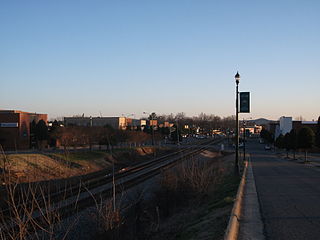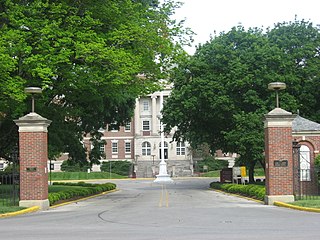
Gaston County is a county in the U.S. state of North Carolina. As of the 2010 census, the population was 206,086. The county seat is Gastonia. Dallas served as the original county seat from 1846 until 1911.

Belmont is a small suburban city in Gaston County, North Carolina, United States, located about 13 miles (21 km) west of uptown Charlotte and 9 miles (14 km) east of Gastonia. The population was 10,076 at the 2010 census. Once known as Garibaldi Station, the name change for Belmont is disputed. Some say it was named for a prominent New York banker - August Belmont. Others contend the Pope ordered the abbot of the monastery to change the name since he would not tolerate an abbey in a place that bore the Garibaldi name. The abbot could see Crowder's mountain from the property and named the town Belmont - "beautiful mountain". Belmont is home to Belmont Abbey College.

Dallas is a small town in Gaston County, North Carolina, and a suburb of Charlotte, located north of Gastonia. The population was 4,488 at the 2010 census. It was named for George M. Dallas, Vice President of the United States under James K. Polk.

Gastonia is the largest city in and county seat of Gaston County, North Carolina, United States. It is the second-largest satellite city of the Charlotte area, behind Concord. The population was 71,741 at the 2010 Census. In 2019, the population had increased to 77,273. Gastonia is the 13th most populous city in North Carolina. It is part of the Charlotte metropolitan area, officially designated the Charlotte Metropolitan Statistical Area (MSA).

Mount Holly is a small suburban city in northeastern Gaston County, North Carolina, United States. The city is situated just west of the Catawba River, north of Interstate 85, south of North Carolina State Highway 16, and west of Charlotte. The population was 13,656 at the 2010 census, up from 9,618 at the 2000 census.

Beaufort is a city in and the county seat of Beaufort County, South Carolina, United States. Chartered in 1711, it is the second-oldest city in South Carolina, behind Charleston. The city's population was 12,361 in the 2010 census. It is a primary city within the Hilton Head Island-Bluffton-Beaufort, SC Metropolitan Statistical Area.

Kings Mountain is a small suburban city within the Charlotte metropolitan area in Cleveland and Gaston counties, North Carolina, United States. Most of the city is in Cleveland County, with a small eastern portion in Gaston County. The population was 10,296 at the 2010 census. During the Revolutionary War, Patriot militia defeated Loyalist militia in the Battle of Kings Mountain.

This is a list of structures, sites, districts, and objects on the National Register of Historic Places in North Carolina:
America's 11 Most Endangered Places or America's 11 Most Endangered Historic Places is a list of places in the United States that the National Trust for Historic Preservation considers the most endangered. It aims to inspire Americans to preserve examples of architectural and cultural heritage that could be "relegated to the dustbins of history" without intervention.

The Raleigh and Gaston / Seaboard Coast Line Building is an historic building in Raleigh, North Carolina, that was once home to the Raleigh and Gaston Railroad and subsequently the Raleigh office of the Seaboard Coast Line Railroad. The three story brick building is one of Raleigh's earliest surviving office buildings and served as a railroad office for more than 100 years.

This list includes properties and districts listed on the National Register of Historic Places in Gaston County, North Carolina. Click the "Map of all coordinates" link to the right to view an online map of all properties and districts with latitude and longitude coordinates in the table below.
Charles Coker Wilson was an American architect based in Columbia, South Carolina. Wilson was born in Hartsville, South Carolina, and graduated from South Carolina College with an engineering degree in 1886, continuing on to receive his master's degree in 1888. He briefly studied architecture in the Atelier Duray at the École des Beaux-Arts in Paris. Much of his work contained Beaux-Arts elements. Architects who worked for Wilson include Joseph F. Leitner, during 1901–1905, who became a noted architect in Wilmington, North Carolina; and Henry Ten Eyck Wendell, during 1905–1906.

Biltmore Hospital, also known as the Biltmore Hospital Extension and Memorial Mission Hospital, is a historic hospital building located at Biltmore Village, Asheville, Buncombe County, North Carolina. It was built in 1929–1930, and originally known as the Battle Wing to the Clarence Barker Memorial Hospital. It is a four-story, 13 bay by 3 bay, brick and stone building with a flat roof and Tudor Revival style design elements. A two-story wing was completed in 1953 for the Imperial Life Insurance Company. Also on the property are contributing culverts and a sign.

Lexington Memorial Hospital is a historic hospital building located at Lexington, Davidson County, North Carolina. It was designed by architect Charles C. Hartmann in a mix of Art Deco and Art Moderne styles. It was built in 1946, and is a large masonry T-shaped building sheathed in yellow brick, three and four stories tall and 17 bays wide. It has a one-story addition on the east end and a 1958 one-story addition off the rear wing.

The Belmont City Hall, also known as the Former United States Post Office, is a historic post office building located in Belmont, Gaston County, North Carolina. It was designed by the Treasury Department's Office of the Supervising Architect under the direction of Louis A. Simon, and built in 1939. It is a one-story, five bay Colonial Revival style brick building. At the rear is a stepped-back rectangular secondary block and loading dock. It housed the Belmont post office until 1970, then was converted for use as the Belmont City Hall in 1973.

Central School, also known as Bessemer City Elementary School, is a historic school complex located at Bessemer City, Gaston County, North Carolina. The main school building was built about 1929, and is a two-story, "U"-plan brick building with Collegiate Gothic detailing. It was rebuilt following a fire in 1942. Adjacent to the school is the Rustic Revival style, rough cut stone gymnasium built in 1933 with funds provided by the Works Progress Administration. Other contributing buildings are the Home Economics Building, Classroom Building, and Storage Shed.

Downtown Gastonia Historic District is a national historic district located at Gastonia, Gaston County, North Carolina. It encompasses 77 contributing buildings and 1 contributing object in the central business district of Gastonia. The commercial, civic, institutional, and multi-unit residential buildings were built between the 1890s and 1954, and include notable examples of Colonial Revival and Classical Revival architecture. Located in the district are the separately listed former Gaston County Courthouse, First National Bank Building, Third National Bank Building, and Robinson-Gardner Building. Other notable buildings include the U.S. Post Office (1935), York Medical Building (1938), Kress Department Store, Leibowitz Department Store, Ideal Moving Picture Theater, City Hall, Kirby Building (1922), First Baptist Church (1922), Gaston County War Memorial Hall (1928), and the (former) Gaston County Public Library (1930).

The former L. Richardson Memorial Hospital, also known as Americas Health Care of Greensboro Nursing Facility, is a historic hospital located at Greensboro, Guilford County, North Carolina. The original section was built in 1927, and is a three-story, seven bay, Mission Revival style stuccoed brick building with a two-bay wide, three-story, brick wing constructed in 1930. A long two- and three-story addition was added in 1945–1946. It was Greensboro's first modern hospital for African-Americans. The hospital moved to a new facility in 1966, and the old building sold for use as a nursing home.

Indianapolis Veterans Administration Hospital, also known as Larue D. Carter Memorial Hospital is a historic hospital complex and national historic district located at Indianapolis, Indiana. The district resources were developed between 1930 and 1951 by the Veterans Administration, and encompasses 15 contributing buildings, 2 contributing sites, 2 contributing structures and 5 contributing objects on the hospital campus. The main complex is connected by an enclosed corridor and consists of the main hospital building (1931), kitchen/mess hall/boiler house/attendants' quarters, general medical building (1939), and recreation building (1941). The buildings reflect the Colonial Revival and Classical Revival styles of architecture.


















